LEDs are an old technology, why did the industries take so long to put them into light bulbs? Was there any technological gap missing?
-
somewhat related video: [The First Light Emitting Diodes.](https://www.youtube.com/watch?v=yusrrOPM43o) It demonstrated how low the efficiency of early LEDs was. – Nick Alexeev Feb 27 '16 at 21:14
-
11From certain perpectives it is a new technology... I guess you never felt like "oh wow, that new LED colour is on the market now, lets get some, oh thats darn expensive" – PlasmaHH Feb 28 '16 at 12:53
-
@plasmahh exactly. And that high cost in turn means that the manufacturer can't mass produce and reduce prices. Catch 22 of new tech economics. – Passerby Feb 29 '16 at 22:36
-
The industry of Asmyldof used to put LEDs in lighting way back before the blue LEDs in the 90's came around. But it gets tiring after a while having to solder 300 yellow LEDs into one night-light, so only a bunch were ever produced and only one survived to this day. ;-) – Asmyldof Mar 01 '16 at 18:28
10 Answers
It is not possible to produce white light without an efficient blue LED, either using RGB LEDs or a blue LED + yellow phosphor.
The breakthrough was the invention of the high-brightness Gallium-Nitride blue LED by Shuji Nakamura at Nichia in the early 1990s.
It still took a while to get the overall efficiency up to the level of fluorescent bulbs, and it's only in the last decade that LEDs finally came out on top.
- 168,369
- 17
- 228
- 393
-
5This explains white, but what about e.g. traffic lights? They didn't start throwing up red / yellow / green LED lights until the early 2000's, at least in towns in the NE USA. Do they use blue in those, too? – Jason C Feb 28 '16 at 22:08
-
24@JasonC: Bright red, amber and green LEDs have been around for a while. However, I don't think there was much motivation to create traffic light bulbs from them at first. For one thing, there's actually a serious drawback: They don't get warm enough to clear themselves of snow! I guess that it's only in the last decade or so that the economies of scale from producing lamps for other applications made it economical to produce traffic signal bulbs as well. – Dave Tweed Feb 28 '16 at 22:14
-
Hmm; it looks like Colorado found a possible solution to that [around 2005](http://www.ledsmagazine.com/articles/2010/01/led-advantages-outweigh-potential-snow-hazards-in-traffic-signals.html) (2010 + "five years ago"), and the implication is that municipalities judge the savings to outweigh the risk. It must be a cost thing, although I suppose it could've just taken a while to convince folks that the benefits were worth that hazard. I wonder if the adoption was earlier in warmer places. I sent PennDOT an email... maybe they'll have some info about the decisions that went into it. – Jason C Feb 28 '16 at 22:27
-
@JasonC The snow problem, and the fact that traffic lights are a slightly bluish green to help people with color blindness. – Damian Yerrick Feb 28 '16 at 22:38
-
@DaveTweed indeed, they've been around temporary traffic lights for a lot longer as these are more expensive to power. LED traffic lights seem to have bee adopted more readily in more temperate climates as well/ – Chris H Feb 29 '16 at 09:56
-
2Funny. The post begins with "not possible to produce white light without an efficient blue LED", then links to the WP article of Nakamura as the inventor of the *blue* LED, with the article linking to how Nakamura later on also invented the *white* LED. ;-) – DevSolar Feb 29 '16 at 14:27
-
26Note that the high-brightness blue LED was a sufficiently large breakthrough that Nakamura, along with two of his collaborators (Akasaki and Amano), won the 2014 Nobel Prize in Physics for it. – Michael Seifert Feb 29 '16 at 14:38
-
17Incidentally, you can use this fact to instantly date works of science fiction on TV or the movies. For example, in Star Trek, TNG, whenever they open up Data's skull to show his positronic net, there's lots of blinking LEDs in there - all red, yellow, or green, because that's what the prop designers had available and affordable at the time. – Darrel Hoffman Feb 29 '16 at 16:11
-
-
8I worked in a (small, non-chain) retail electronics store just after high-brightness blue LEDs had become available (circa 2000). Red/green/yellow were sold in bulk for pennies, while a single blue high-bright LED sold in a blister for about $10 MSRP. – SevenSidedDie Feb 29 '16 at 18:18
-
1@JasonC for traffic lights, I'm seeing LEDs mainly built in in a non-bulb form (i.e. a flat array of LEDs) here in Berlin, Germany. – Paŭlo Ebermann Mar 01 '16 at 20:53
-
I just got an *awesome* response from PennDOT about the decisions leading up to traffic light replacements in the early 2000s. I will share more later when I'm not on my phone, but essentially the reason for waiting was similar to blue: At that time red was super cheap, amber and green were still a bit too expensive, and not yet available in traffic light form. Snow wasn't considered. I wonder if the cheapness and availabity of red also explains why power and other indicator lights tended to be red; like I remember http://www.handheldmuseum.com/Mattel/BaseB.htm being red (1978). – Jason C Mar 07 '16 at 15:03
-
And even the best and most expensive LED bulbs lag behind traditional incandescent bulbs in terms of perceived color quality. So even today it's not perfect. – vsz Jul 27 '16 at 07:14
It took a long time to produce LEDs that had a reasonable "colour temperature" (shade of white), and suitably high efficiency. The normal operating principle of LEDs produces only a single band of light, like a laser. So the white ones are made of a blue or UV LED and a phosphor re-emitter.
For easy replacement of conventional light fittings, LED bulbs also need a small, cheap, constant-current AC-DC converter. This is usually some kind of switchmode power supply. These too have only really become cheap and widely availble in the past decade.
See also the L-Prize.
- 46,540
- 4
- 64
- 126
-
5LED emission is a lot broader, spectrally, than a laser. Lasers are extremely monochromatic because they provide a feedback mechanism (stimulated emission) that concentrates the optical amplification into an extremely narrow wavelength band. LEDs, on the other hand, produce a rather broad spectral emission by comparison. There are no coherency effects with an LED, for example (speckle, interference, etc.) – J... Feb 28 '16 at 16:31
-
@J...: `There are no coherency effects with an LED` - there are no coherency effects with some LEDs. There are with others. Specifically, there are coherency effects in so-called laser LED's (there is a question on physics.se if such lasers should be called "lasers" since the coherent light is created without the aid of stimulated emission) – slebetman Feb 29 '16 at 04:48
-
4@slebetman Laser diodes are still lasers, and they certainly use stimulated emission. – J... Feb 29 '16 at 10:26
-
A lot of LED light bulbs (possibly the majority, especially for cheaper ones) use a simple capacitive dropper, not a switch mode. – grahamparks Mar 04 '16 at 17:58
The majority of the answers thus far have focused on the technical challenge of replicating white light with LEDs, with development of the blue LED being the major breakthrough on that front. Some mention has been made of the difficulty of developing blue LEDs with sufficient efficiency to make a practical lamp. While this may be obvious to practicing EE's, I think it's worth elaborating in more detail why too low an efficiency represented such a hindrance to commercialization: namely, plain old heat.
An often-quoted advantage of LEDs is that they don’t produce heat, and are cool to the touch. Fact or fiction?
In one sense this is true: LEDs are cool to the touch because they generally don't produce heat in the form of infrared (IR) radiation (unless of course they are IR LEDs). IR radiation heats the enclosures and surroundings of incandescent bulbs and other sources, making them hot to the touch. The absence of IR radiation allows LED fixtures to be positioned in locations where heating from conventional sources would cause a particular problem e.g. illuminating food or textiles.
However, crucially, heat is produced within the LED device itself, due to the inefficiency of the semiconductor processes that generate light. The wall-plug efficiency (optical power out divided by electrical power in) of LED packages is typically in the region of 5-40%, meaning that somewhere between 60 and 95% of the input power is lost as heat.
The energy consumed by a 100-watt GLS incandescent bulb produces around 12% heat, 83% IR and only 5% visible light. In contrast, a typical LED might produce 15% visible light and 85% heat. Especially with high-power LEDs, it is essential to remove this heat through efficient thermal management. Without good heat sinking, the internal (junction) temperature of the LED rises, and this causes the LED characteristics to change.
...
Most significantly, the junction temperature affects the lifetime of the LED. Unlike other light sources, LEDs don’t tend to fail catastrophically (although a small number do, especially if you cook them); instead, the output of the LED decreases over time.
(emphasis added)
— T. Whitaker. "Fact or Fiction – LEDs don’t produce heat". LEDs Magazine, May 2005. http://www.ledsmagazine.com/articles/2005/05/fact-or-fiction-leds-don-t-produce-heat.html
A Google Images search for "led bulb heat sink" turns up a veritable zoo of heatsink designs:



(Click images for larger versions)
I suspect that there was some lag in market penetration due to the striking difference of form factor required for thermal management.
- 279
- 1
- 11
-
5Several people have already mentioned improvements in efficiency, which is the same thing as generating less heat per lumen. Notice also that the first article is from 2005, which is a very long time ago considering the speed at which LEDs have been evolving. – Nick Alexeev Feb 29 '16 at 04:54
-
3@NickAlexeev The uses I see of *efficiency* in all of the answers so far are single uses of the word, or in short phrases. I'm a ChemE, not EE, so perhaps my intuition is askew for EE.SE, but when I read them I hear *they cost too much because they use too much electricity*, not *they generate so much heat that they damage themselves*. I felt some more detail on the practical considerations of heat management was warranted. Sorry I jammed my thumb in your eye. – hBy2Py Feb 29 '16 at 05:53
-
2@Brian Incandescent bulbs produce more heat than LEDs. But they are also more tolerant to heat, because they don't have electronics. LEDs produce less heat than incandescent bulbs. But they are also less tolerant to temperature, because they have electronics onboard. So what's another, say, 3W of waste heat among friends? Well, 3W worth in electricity bill is not that big of a problem (we've just saved maybe 70W, compared to an incandescent). On the other hand, having to reject additional 3W is an issue, because addition heat sinking increases cost. – Nick Alexeev Feb 29 '16 at 06:10
-
The %ages you quote are %ages of different things. For a given light output, the LED will need 3x less input power, so the "heat" produced will be 85%/3 ~= 28% of the incandescent bulbs input power. That's still 2½ times as much as the incandescent - but it's not the 7x that the original numbers imply. (OTOH, the LED is more sensitive to heat than the incandescent.) – Martin Bonner supports Monica Feb 29 '16 at 13:20
-
1@MartinBonner Well, yes, of course. I wasn't trying to make a quantitative comparison of heat outputs, though, but merely aiming to highlight that despite their lay perception as "cool", LEDs do generate a significant amount of heat relative to their total energy consumption; and, further, as you note in your parenthetical, that they are sensitive to this heat production if not well designed. – hBy2Py Feb 29 '16 at 14:56
-
2While I understand what the quoted material is getting at the way its defining heat and IR as separate things makes me cringe. – Dan Is Fiddling By Firelight Feb 29 '16 at 15:40
-
3@DanNeely They *are* separate things, though. Aside from "LEDs are cool to the touch because they generally don't produce heat in the form of infrared (IR) radiation," which is wrong because LEDs are cool because they are much lower-power devices per-lumen, the quote's description is completely accurate. **IR radiation is not heat.** Most materials absorb IR very readily, true, converting it to heat where it strikes, but IR crosses gas & vacuum at the speed of light whereas heat cannot. Thus, in light bulbs, 1W of heat is more localized than 1W of IR. – hBy2Py Feb 29 '16 at 16:04
-
Although it doesn't answer the question, it made for an interesting read, all pedants aside. Thanks for being one of the reasons I like stackexchange ;) – Grimace of Despair Mar 02 '16 at 04:24
-
8Technically speaking, light bulbs are merely resistors which can produce nothing but heat. That heat gets transformed into IR and light via [black-body radiation](https://en.wikipedia.org/wiki/Black-body_radiation). So **a light bulb produces 100% heat** which is dissipated differently: 88% via radiation and 12% via heat transfer. – Dmitry Grigoryev Mar 02 '16 at 14:44
-
2
Another minor, non-technical, aspect that contributed to a few year delay was the patent issues related to blue LED production.
Nichia, where Nakamura worked, had many key GaN (Gallium Nitride) patents, but not all. Others, such as Cree (SiC patents) and Toyoda Gosei (other LED patents) had other key patents necessary to produce blue LEDs in high volume.
The technical issues were generally figured out by the late 1990s, but the big LED players were not producing any quantity of blue LEDs (partly, mostly?) because of patent litigation issues.
By late 2002, a few key patent cross-licesning agreements were completed and within 1-2 years there was a huge increase in the volume of blue LEDs being produced.
Cree and Nichia Announce Patent Cross License Agreement and Settlement of Litigation http://www.nichia.co.jp/en/about_nichia/2002/2002_111301.html
Nichia and Toyoda Gosei settle LED dispute http://www.eetimes.com/document.asp?doc_id=1178214
- 131
- 3
Don't overlook the simple fact of cost either.
Ordinary incandescent bulbs can be made for pennies, and sold for not much more.
- 4,145
- 15
- 18
-
4Making an incandescent bulb is by no means trivial though – delicate wound wire of tungsten (tricky material to work), needs to be suspended very carefully in a well-sealed bulb... it was of course mass-production that got down the prices, but single low-power LEDs have long been cheaper than any incandescent bulb. – leftaroundabout Feb 27 '16 at 20:40
-
6Single low-power LEDs may have been cheaper than incandescent bulbs, but it would take a *lot* of those 20 mA LEDs to light up a room. A big factor in the appearance of usable LED lamps was the [Phasing out](https://en.wikipedia.org/wiki/Phase-out_of_incandescent_light_bulbs) that happened in many countries in the last 10 years, which stopped LEDs having to compete with the cheap previous status quo. – Guntram Blohm Feb 27 '16 at 21:38
-
1If you factor the cost of electricity, LED lights are cheaper than incandescent bulbs. A 10 W LED produces the same amount of light as a 60 W bulb. That's a 50 kWh power saving per 1000 hours. Where I live (in Sweden), that is 10$ off my electrical bills per 1000 hours of burn time and LEDs typically last several thousand hours. – Klas Lindbäck Mar 01 '16 at 13:27
-
1While I agree that the running cost eventually pays for itself, the question was about why it took so long for LED bulbs of usable intensity and color to appear. At home, I am switching as things burn out, but still Incandescent bulbs go for about a dollar a 2 pack, where LED's of decent quality start at about $10 each. – R Drast Mar 01 '16 at 14:28
-
2There is also the general public mindset and law issues: The fluorescent lights producers campaigned and passed laws against incandescent bulbs. It created the void that was filled by leds (instead of fluorescent). – Agent_L Mar 02 '16 at 12:32
This is a question of economics and public inertia. Legacy technology is cheaper to produced due to long term investments in infrastructure and mass production. New technology has to go through funding issues, initial investments, infrastructure building, marketing, slow early adopter stages, distribution deals, etc. If it wasn't for legislation in the US forcing a way for new tech, most would still be on incandescent instead of the current mix of incandescent, CFL, led. It's not a natural capitalistic invisible hand of the free market forces, but a forced adoption.
The benefits of leds comes second to most people, who are lethargic in technology adoption, especially in the face of higher initial costs.. Most people balk at a 20 dollar led bulb compared to a 3 for $3 incandescent, even if the led bulb will outlast 20 incandescent bulbs at half the operating cost. It's only now that individual led bulbs are down to the 5~10 dollar range that people are really moving towards it.
- 72,580
- 7
- 90
- 202
-
3"This is a question of economics and public inertia" It's also a question of LEDs (and, especially, white LEDs) not being remotely as old a technology as the question supposes. – David Richerby Feb 28 '16 at 23:55
-
1@davidricherby and incandescent technology preceded Edison by years, but his employee created a cheap long lasting version that he marketed very well. The creation date isn't that important. – Passerby Feb 29 '16 at 22:40
The problem was to create natural white light. Normal daylight has a spectrum of frequencies in it, but leds can only produce on certain wavelengths. So the engineers had invent different materials to produce different wavelengths. then different leds are mixed together so the resulting light is pretty much natural white.
-
2Actually white LEDs use an ultraviolet or more typically today a blue LED to stimulate a layer of phosphor that emits the white light. It is true that when you see a large display panel for video that it uses multiple primary color leds and the human eye can see the leds blended together. – Craig K Feb 29 '16 at 15:46
First, around 40 years ago, they invented the red LED. Then came progressively blue/green/other colors following different technologies evolutions. Also, the first diodes were not very powerful.
So, the issue was to make white light emitting diodes, and to make them powerful enough to be competitive against lightbulbs, which happenned only less than 10 years ago. And white diodes are still very expensive, but the cost is largely compensated by their durability. Try to look up for the price of a single Audi/BMW/whatever full-led headlight and you'll understand.
- 1,051
- 8
- 20
-
4Blue LEDS came very late. Initially, it was red. Then green. Then yellows and oranges. We had to wait years for blue, and the early ones were hideously expensive and not very efficient. – Simon B Feb 27 '16 at 21:38
-
1@SimonB A book chronicling the development process might be titled something like *Band Gaps on the Rack*. :-) – hBy2Py Feb 29 '16 at 16:17
-
1Vehicle headlights are a bad example; their high prices are due to other factors, LED or not. High power white LED emitters mounted on a star aren't terribly expensive; they can be had in small quantities for under $5 each. There are flashlights available with these emitters for as little as $10-20. – Taudris Mar 01 '16 at 00:54
Every application of lighting has its own demands, and usually those have been solved for more than a hundred years. New solutions are rarely superior in both quality and cost from the beginning. Another not yet mentioned example is the CRI (Colour Rendering Index).
While incandescent bulbs have a spectral response that is similar to a blackbody (hence we have the colour temperature system), white LED lighting does not.
Even those with marketed "ultra high CRI" of almost 100 like in the image above (some google image search hit) do produce only superficially similar light output as incandescent bulbs or the sun.
For a lot of applications this is fine, but especially the difficulties of rendering skin colour makes it unsuitable not only for a lot of media applications but also makes people in your living room somewhat look sick.
Also quite some other areas have a need for proper colour rendering, like people selling stuff where colour is important.
This all might be a small part, but all the other answers mentioned other points that might be small on their own too, but in total give the market enough inertia as if there hasn't been all those little problems in the beginning.
Take tomorrows technology with cheap tiny SMPS and 99CRI white LEDs back to 1997 and everyone will almost instantly switch to that technology.
They also had to get the correct voltage and amperage going through the LED's to make them last almost forever and get the brightest white on the white LED's where it didn't matter quite as much on red, green, etc LED's. Incandescent bulbs may cost pennies to make but since the Spiral Compact Fluorescent Light Bulbs came out that was supposed to last for years but by no means do not, incandescent bulbs are fewer where you buy them and have went up quite a bit in price and since they use lower voltage, I see CFL bulbs getting cheaper and cheaper built not to last as long as they do now and incandescent bulbs getting higher.
- 9
- 1
-
6I'm not the downvote, but this answer is incoherent and makes a number of incorrect and unsupported assertions. I would suggest you revise or withdraw this answer. – DrFriedParts Feb 29 '16 at 03:20
-
Cheap efficient power-conversion is indeed an issue which many "bulbs" still don't solve very well, but your answer is not written very well. – supercat Feb 29 '16 at 23:58
-
1I'm also not the downvoter. But "amperage" is a word used on TV, not on an EE forum. Use "current" instead :) – Reversed Engineer Mar 02 '16 at 12:43
-
Also, voltage doesn't go through an LED. I understand why you were downvoted, although I didn't – Reversed Engineer Mar 02 '16 at 12:45
